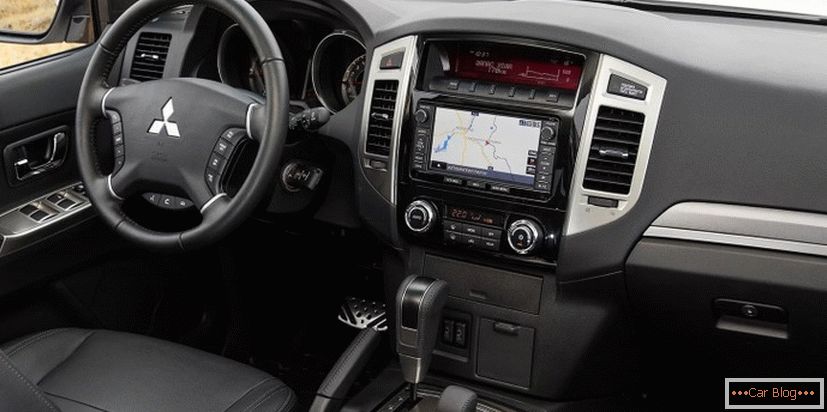An automatic transmission is a device that provides a choice of gear ratio in accordance with the conditions of the road surface, terrain and speed without the direct participation of the driver. In a car equipped with an automatic transmission, the accelerator (gas pedal) sets the speed at which the car moves, and does not determine the engine speed - this is the principle of the automatic transmission.
Content
- 1 A little about the history of the invention of automatic transmission
- 2 The device is an automatic transmission
- 3 The principle on which the automatic transmission
- 4 Features of the use of automatic transmission
- 5 Rules of operation of the machine
A little about the history of the invention of automatic transmission
History shows that the automatic transmission was invented somewhere in the thirties of the twentieth century. From the very appearance of such a transmission, the principle of operation of the automatic transmission has not changed, but, depending on the time and those or other technical requirements, it has been constantly supplemented. Thanks to such additions, automatic transmissions appeared, differing in their variants and models. Different manufacturers have different technical specifications.
With distinctive characteristics, all automatic transmissions have one principle of operation. This is due to the fact that they have almost the same device, if you do not take into account some small nuances.
The device is an automatic transmission
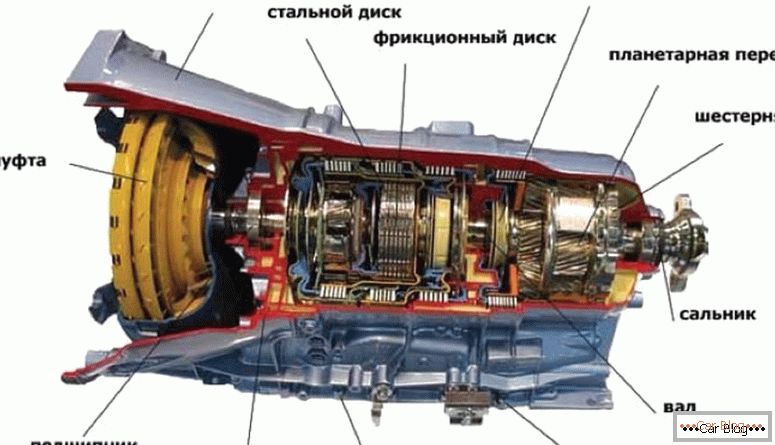
Automatic device
- The main is the torque converter, which is also called the hydraulic clutch - a mechanism located between the engine of the car and the gearbox housing. The functional task of the fluid coupling is the transmission and redistribution of torque during the start of the car;
- The torque is transmitted indirectly by means of planetary gears;
- Friction clutches are responsible for choosing one or another gear, they are often called a “package”;
- One of the mechanisms is the overrunning clutch, which basically performs the function of reducing blows in “packages” during gear changes. In some cases, when the automatic transmission is running, the overrunning clutch disengages braking using the engine;
- The box also includes drums and connecting shafts;
The principle on which the automatic transmission works
To control the automatic transmission there is a special set of so-called spools, which direct the oil under a certain pressure to the pistons in the friction clutches and brake bands. It is possible to set the position of the spools in automatic or manual mode, using the shift knob.
See also: How to replace the boot of the outer CV jointIt is also necessary to know that the automatic control of the automatic transmission can be hydraulic and electronic. Hydraulic is called automatic, using the oil pressure obtained from the centrifugal regulator. In turn, the centrifugal regulator is connected to the automatic transmission shaft, which is located at the outlet. The hydraulic system is designed to use oil pressure in accordance with the position of the accelerator. The machine is given information about the position in which the gas pedal is located - this is the command for the spools to switch.
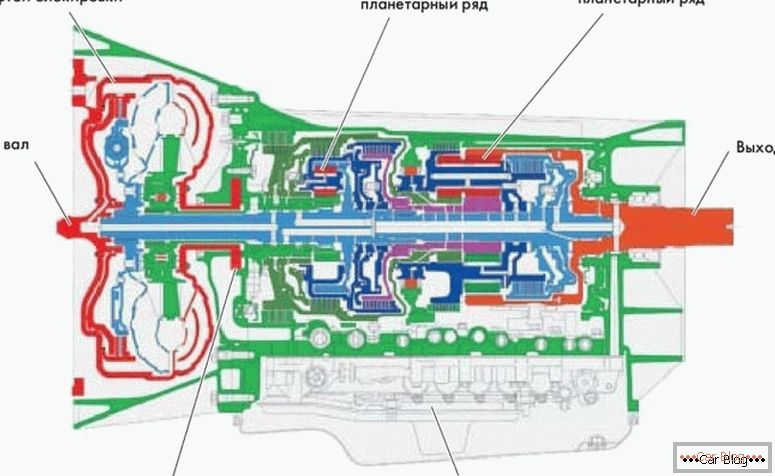
Automatic transmission scheme
In the electronic control system there are solenoids responsible for the movement of spools. Solenoids are connected to the automatic transmission control unit by cables, variants of their connection to the control of the ignition system and fuel injection are also possible. In this case, the movement of the solenoids is controlled by an electronic control unit. The unit controls the solenoids also depending on the position of the gear knob, the speed at which the car is moving and the accelerator position.
Features of the use of automatic transmission
In order to avoid various breakdowns and troubles you need to know how the automatic gearbox works and how to use it. Cars equipped with automatic, are very practical and comfortable vehicles. Even in spite of the fact that many motorists are skeptical about such transmissions, they are very popular. Usually it all depends on what the person is used to. If the driver loves the dynamics, speed, then the automatic transmission is not an option for him. Having examined the device, technical characteristics and how the automatic transmission works, it becomes clear that it is intended for people who prefer a calmer driving style.
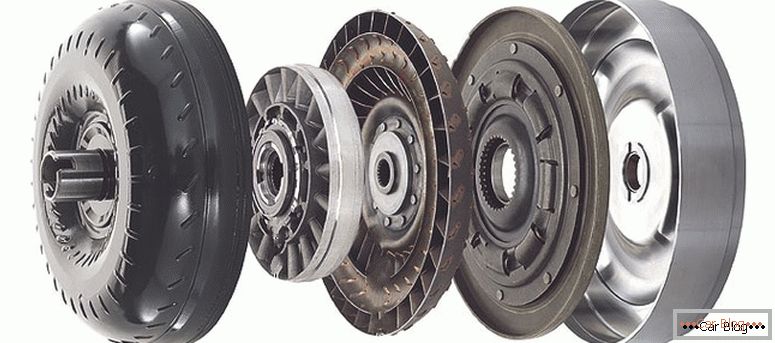
The torque converter performs the function of smoothly connecting the box to the engine
In any case, before you begin to master a car with a gun, you need to learn all the nuances and rules for using such a transmission. It is important to understand that by neglecting some of the features, you can disable the automatic transmission in a relatively short time. You also need to know that the repair or replacement of the entire automatic transmission will cost a round sum.
Rules of operation of the machine
Even if the entire transmission is electronically controlled, the driver is required to follow certain rules for controlling it with the gear selector knob:
- Before starting the engine, the selector should be in the “N” (neutral) or “P” (parking) position. It is imperative to squeeze the brake pedal;
- Before driving with the brake pedal depressed and the button turned on, which is responsible for the selector lock, the desired mode is selected. In no case can not add gas when switching the selector;
- After stopping the machine, it must be put on the parking brake (handbrake), after which the selector lever should be moved to the “P” position. Such a sequence is caused by the fact that a car that is not set to the emergency brake can move arbitrarily on the descent, and this can cause a blockage in the automatic transmission of the parking wheel. Therefore, for insurance, you always need to clamp the handbrake and only then you can already transfer the selector to the “P” position;
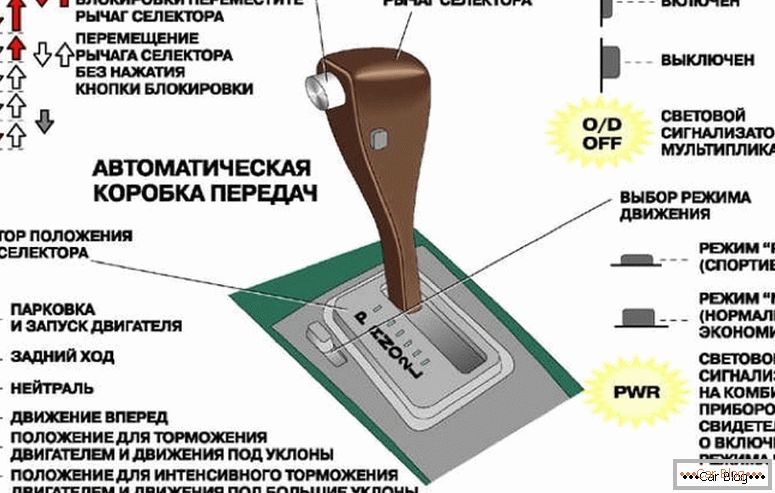
How to control the box machine
- It is necessary to learn that, stuck in a swamp or snow, it is unacceptable to use the so-called method of rocking a car with the help of gas. To translate the selector switch to different positions, for example, "R" or "D" if the car is not completely stopped is strictly prohibited - this can lead to serious damage and subsequent costly repairs;
- Automatic transmission has its own characteristics when driving in different weather and climatic conditions. For movement in the winter period, the selector positions "1", "2", "3" and "W" are used. Also in winter, driving in a car with bad tires is contraindicated - the auto skidding determines that the car moves without load and begins to turn on increased speeds;
- When driving with a trailer, the speed should not be more than 80 km / h, and the selector should be in position "3";
- Most cars are recommended to be towed using the 50/50 formula (towing distance is no more than 50 km, and the speed should not be more than 50 km.) There are models that are generally forbidden to tow;
- Various spectacular starts and turns on the spot are also prohibited. When simultaneously pressing the gas and brake pedals, the oil in the transmission begins to boil, and the automatic transmission can simply burn.



